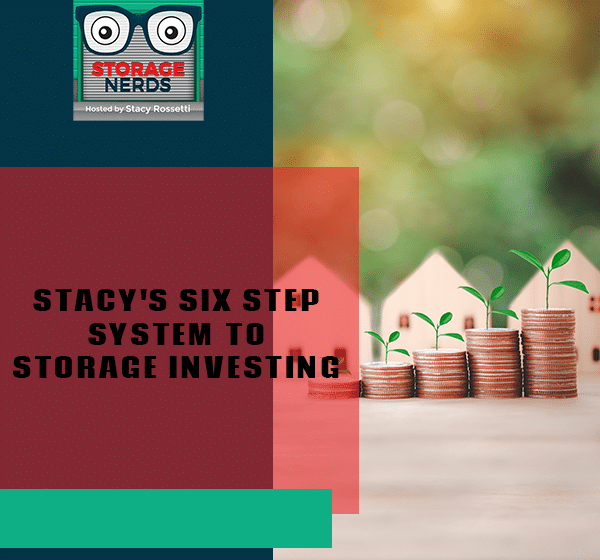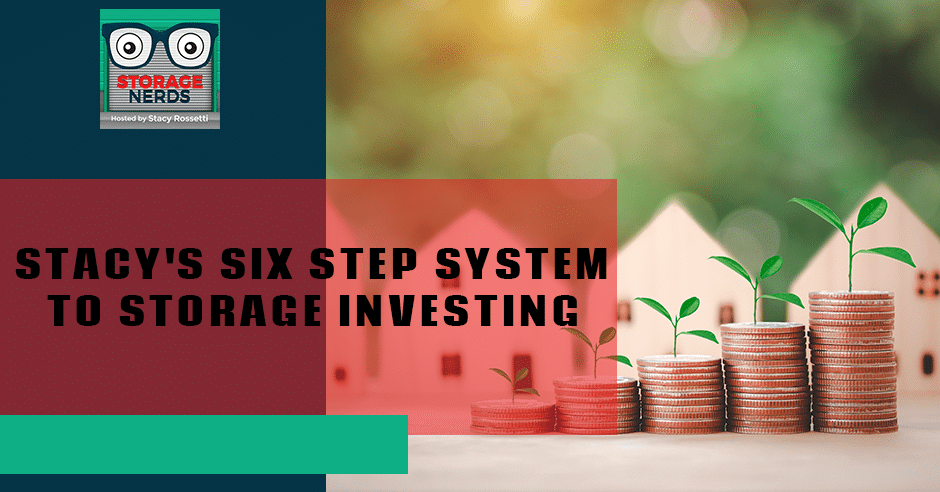Want to jumpstart your path to self-storage investing? Then this episode is a must! Host Stacy Rosetti shares with you the Super Simple Six Steps To Storage! She breaks down the six-step system, which includes: office/admin, marketing, acquisition, finance, management, and liquidations. Stacy gives you the basics in setting up your self-storage business and shares practical tips along the way. To know more, listen in to get started and check out the full Super Simple Self-Storage Online Course!
—
Watch the episode here
Listen to the podcast here
Stacy’s Six Step System to Storage Investing
We did what I call an In-field Training Day where I took a group of students out. There were nine of us in total. We went out, drove for storage and hung out. It was a lot of fun.
We talked to one guy and I told him I wanted to buy his facility and he said, “$2 million,” which is what they always say. I said, “I’ll pay $2 million. What’s your income? Do you have proof of income so I can show my lenders because they’re going to ask that?” The guy’s eyes went super big. He was like, “She means business.” It was fun to do that.
We talked to another guy. I was like, “Are you the owner? I’d like to talk to the owner to see if he wants to sell.” He said, “He doesn’t want to sell.” He was the manager of the facility. The facility owner would’ve at least wanted to talk to me. I tell my facility manager all the time, “If somebody calls you and they want to buy our facility, please let me know so I can decide on whether or not I want to sell my facility. It isn’t your decision. It’s my decision.”
Driving for storage equals market research.
While driving I found a couple of good areas. It was a nice up-and-coming area. I was like, “Why are there no storage facilities here?” When you get out, start doing market research, driving and thinking yourself like, “Along this highway, there should be a storage facility,” but there’s not. That would be like a clue that you should be building there if you’re interested in building.
I like to do the In-field Training because I get to meet all my students. StorageNerds is completely virtual. I don’t get to meet anybody unless they show up and come hang out with me for the day. I got to meet a good handful of my students and we got to hang out and talk shop.
I love driving for storage. I’m so proud of my students. I’ve been doing coaching calls all day. They’re getting out and talking to owners. The only way you’re ever going to find a facility is if you talk to owners. #DrivingForStorage. If you do go out and drive for storage, tag me with #DrivingForStorage to see you are driving for storage. Take a picture of yourself while you’re out looking for storage.
Start putting it out to the universe that you want to buy storage facilities because the universe listens. If you put it out to the world, it will hear you. #DrivingForStorage equals market research. What that means is that if you are out driving for storage, we’re getting to know the market. You’re getting to know what facilities are out there.

I talked to one student and she was like, “I drove for an hour. All I saw were big box companies.” I was like, “You never left the primary market.” Probably in her area because she’s in the Northeast. It’s a tertiary market. The secondary and primary markets are so expensive. Unless she has millions of dollars, but she doesn’t. She needs to be going further out.
We sat, looked at the map and tried to figure out which area would be good for her to be focusing on. She was like, “I want to have a facility closer to me, not so far out.” I said, “You need to wholesale the first couple of storage facilities and then once you make the money on those wholesale deals, $50,000 on each, then you could take that money and use it as a down payment for a bigger facility that’s closer to you.”
That’s why I told her to do it because she wants to have something closer to her area, but she lives in the secondary market and the facilities are too expensive out there. She needs to wholesale and then maybe come up with a good amount of money for a down payment. Still get out there, look and find something. When she comes across something that she wants to buy, then she can partner with somebody or one of the students in the group. There’s a lot of students in that area. I said, “Get out there and make some money first.” That’s how I did it.
Driving for storage equals market research. Get out there, start driving around and look at the facilities that you have. Go as far out into the country as you can so you can see what a primary, secondary and tertiary market looks like. You want to know and understand all three markets.
We’re going to get into my Six-Step System and I’m going to break it down even more. I’m getting super deep. This is derived from my teaching for many years.
One way to find facilities is by checking Google business listings.
You’re setting up your office and you got marketing, acquisitions, finance, management and liquidating. These are all the different departments of your business. This is a step-by-step process that I call the Six-Step System. This is what a self-storage investing business looks like. Even though you visually can’t see this, all of these departments and steps here are working at the same time. It’s a lot of work and this isn’t easy. I wanted to dig a little bit deeper into that.
Office/Admin: Setting Up Your Office
I talked about your first step, which is your office admin. This is you setting up your office. First, you’re going to need to structure your company. I’m not going to get into that too much. A self-storage company is an LLC most of the time, unless you get into bigger facilities and stuff. Your very first facility, you’re going to have it as an LLC but you want to learn how to structure your company properly.
In the Super Simple Self-Storage Course, this goes for my students and non-students reading. There’s a bonus section. It’s from guest speakers. One of my good friends, DeOnna Britt came and talked to the StorageNerds years ago. She taught all the different ways that you can structure your business. That’s a bonus when you buy that course. It’s called Business Structuring 101. She goes into all the different types of business structures out there.
The first thing is how you structure your business. My husband’s going to teach things like land trusts. We do a lot of estate planning and stuff like this. In commercial real estate, once you get into this, you start owning a lot of property that’s expensive. The good thing about investing in commercial real estate is you start owning a lot of property that’s worth a lot of money. You’re like, “I have a lot of money. What do I do? How do I structure and protect everything?”
A land trust is another thing that you can learn under office admin. We have a guest speaker named Randy and he’s my coach on land trusts. He came and talked to the StorageNerds Group as well. He went over a whole section on land trusts, how to set them up, what they are and stuff. He’s a guest speaker in the Super Simple Self-Storage Online Course. You can watch that as homework as well too. That’s also in the course.

You want to be completely electronic and virtual, which means that you want to be in the cloud. Everybody knows this. If you’re not in the cloud, then that means you’ve got to be at home doing your stuff. Pete and I can run our businesses from our phones. I do it because I live in an RV and travel. Half the time I don’t get internet because it doesn’t work. I got to run off my phone a lot of times. You want to be managing and running your business from your phone.
Are you completely 100% virtual? If you’re still sitting there with a file full of papers and stuff, you aren’t in the 21st century anymore. Contracts are electronic. Everything’s electronic. You want to work on getting into the cloud. That’s office admin.
Another thing that we do here is the phones. Make sure you have a business phone and then the phone that you talk to the sellers. You don’t want two phones, but you want two lines. You don’t want the people you’re talking to about buying their properties calling the same number your tenants are calling. It’s like a business line and then a tenant line for your company.
We’ve got a lot of facilities. We’ve got fifteen lines, but you want a separate line that is your business number. That’s the stuff that we go over, plus a lot more, but I can’t think of. That’s setting up your office. We’re getting ready to get some phone calls. I want to get you ready to get some phone calls coming from sellers.
Marketing: Strategies to Find Deals
Step two is marketing. You all know the different strategies on how I find my facilities, how I do this driving for storage and using Google Maps. You’re going to be online looking for facilities and then calling owners. You are using Google Maps to find facilities.
I’ll give you one good tip. One of the ways that we find them is by checking Google business listings. Think about when somebody wants to rent a storage facility. Where do they go? They go on their phone, open up Google Maps and then type storage near me or something like that. All the storage facilities in the area come up. You can go through and check them to see if their Google business listings are filled out properly. That’s one of the many ways to find storage.
You can’t put any offers until you find deals. Step one is finding deals.
This is the grassroots level. This is not like, “Let me go look on the MLS.” Every storage facility that comes up in the MLS for Georgia, I get notified. My realtor is looking for storage facilities for me on the MLS every day because he wants to make some money off me. I got an email from him for a storage facility for sale on the MLS for a long time. If you go on to Crexi or LoopNet, you got way too many people trying to get those deals if it’s a small deal. Also, the numbers are not good. You want to be talking to the owners directly. I teach driving for storage, using Google business listings and Google Maps.
You can’t put any offers in until you find deals. Step one is finding deals. Getting out there and looking. I talked to so many students. In all my coaching calls, everybody’s finding deals. You’re all getting out there and looking for some deals. One of my students got a good deal. I can’t wait to buy this sucker, 720 units for a $3.6 million deal. It’s such a good deal and we’re getting that one on the contract. We got a lot of good deals. I’m so excited.
We got some marketing going. You need to have a couple of different marketing strategies, driving, calling owners and looking on Googles Maps. If you’re like, “I’m only going to be cold calling. That’s it.” It doesn’t work. You have to have a couple of different strategies going. You’re starting to talk to owners.
Acquisition: Commercial Deal Analysis and Making Offers
Step three is acquisitions. This is a commercial deal analysis. What that means is that you’ve got to learn how to run numbers for commercial property and storage facilities. The funniest thing is I have the student too and she’s like, “I was calling around. I have a guy. He has a storage facility but also has an RV park and he wants to sell both. How do I run the RV park numbers?” I was like, “It’s the same way that you run storage facilities, except for there’s no square footage.”
Other than that, you’ve got to know the purchase price, vacancy, total income and expenses, all the basic stuff. She sat there, used the deal analyzer and ran the numbers on an RV park. We came up with the number. She said he wanted $500,000. I said, “$500,000 is a good price for this thing. Put an offer in $450,000.” She’s going to put an offer in for $450,000 on this RV park. Talking to the owner, he wants to sell both. She’s putting an offer for both. If we don’t want it, then we’ll wholesale it to somebody else because everybody wants to buy RV parks.
When you learn commercial deal analysis, you get to learn how to run deal analysis on all commercial deals. It’s the same concept, except it’s a different product. That’s why I love the commercial. You can buy buildings, retail buildings, RV parks, mobile home parks, storage facilities and multifamily, so you could do all of that with commercial deal analysis, which I love personally.

I was talking to a good friend, Carson. He bought three mobile home parks. He was sitting there and talking to me about how he runs his numbers. He’s got his net and gross. He’s like, “What about you?” I ran mine. I was talking about how I do mine. It was the same thing. I was like, “This is awesome.” We were talking in commercial deal lingo to each other. I was like, “It’s good to be able to talk to people that get me.”
Learn how to run commercial deal analysis. When you joined StorageNerds, you get the deal analyzer. I have a video that goes through it. You can start looking and running numbers but you have to learn things like CAP rate, yield and ROI. As you get into it, you’re going to learn, “What’s the CAP rate or cash-on-cash return?” You’re going to learn things like what are some of the stuff that goes into analysis? The purchase price, vacancy rate, total square footage and unit mix. That’s the acquisition department.
Also under acquisitions, it’s all about making offers. You learn how to run commercial deal analysis that you can make offers. That’s what you want to do. You want to make an offer. I keep telling all my students like, “Make offers. Who cares if they take it or not? It’s practice.” That’s what it is. They can be like, “No, you’re stupid. You suck. I’m never going to sell it.” They could be like, “Let me think about it.”
Make an offer based on what you feel is the best number. You don’t want to be making an offer like, “I want this deal and make an offer.” Sometimes I have to talk my students out of making offers because they’re so desperate to get a deal. That’s why you have to learn commercial deal analysis. You got to put offers. When you make your offer, you want to truly understand your area’s primary, secondary, and tertiary markets.
We go over this primary, secondary and tertiary. You want to know in the primary market, it’s a 4% to 6% cap rate. In a secondary market, it’s a 6% to 8% cap rate. The tertiary is 8%-plus. We’re running numbers at an 8% cap or less and I focus on secondary to tertiary markets. I’m a 7% to 8% cap kind of girl. That’s what I am.
You want to make sure that you make an offer based on your area. One of the things that I noticed a lot of people struggle with is what’s called the market cap rate. That’s what this is. In this area, what’s the typical price that a facility is going to be selling at? I always teach this because when you go onto Crexi or LoopNet, you start looking at deals and you’ll see a tertiary market facility selling at a 6% cap. When you go online, you’re going to find that but when you talk to a seller face-to-face, you’re not going to get that number. You’re going to get a higher cap rate.
You want to buy the highest cap rate you possibly can and sell at the lowest cap rate. That’s what you want to do except for mismanaged facilities. That’s a whole different bug. Most typically, you buy high, sell low. Also, in the Super Simple Self-Storage Course, you’re going to learn total population divided by total square footage equals 6% to 8% per capita.
When you find a facility in the storage, investing in world competition is super-duper important. We don’t run comps on residential. You don’t look at what other store facilities sold for. You look at income and then the competition. What does it making and what could it be making? That’s it. When you get it and look at the deal analyzer, that is why we have as-is versus potential versus opportunity.
As-is versus opportunity is what you’re looking at. As-is, what’s the income and based on what the competition is selling for. This is what we could be doing. A lot of REITs or bigger companies are going to be like, “What’s the cashflow?” They’re focused on cashflow. How much money do we make regularly? When you borrow that money from a fund, you got to be paying it.
There’s no reason for you to be any cheaper than anybody else.
On the opportunity side, looking at the competition will help you determine the fair market value for your price per square foot is. You should be at that. There’s no reason for you to be below. I had one student who bought a $3 million facility and she’s like, “Should I tear the Band-Aid off and go for it or should I do incremental adjustments?” I was like, “Tear the Band-Aid off.” There’s no reason for you to be any cheaper than anybody else.
You are going to be higher than everybody else. That’s your goal and what you need to look at. When you start finding facilities based on as-is versus opportunity based on the competition, then what you’re going to do is, “I can buy it at this much and increase it to this much.” The question is, is it a good area to buy in?
In a primary market, you’re less than 1 mile from the radius of where you should be looking at your competition. In secondary, less than 3 miles. In tertiary, less than 5 miles. Sometimes in tertiary, you could go up to 10 miles. We bought a couple here in Florida and the town has around 10,000 people. In a 10-mile radius, there are 25,000 people. In tertiary, you can go bigger radiuses, but in that radius of where that facility is that you want to buy, you’re going to look at the total population of that number in that radius divided by the total square footage.
How do you find the total square footage? You either have to manually do it or figure it out by doing some research and using software to find the total square footage. That is what you need to do. If the number is between 6 and 8, then it’s a thumbs up. If it’s below or above, it’s a thumbs down. Primary, secondary and tertiary markets are like when you are driving and you are seeing big box companies like U-Haul, Extra Space Storage, Life Storage, Cube Smart. You are in a primary market.
I’ve noticed that these big box companies are moving into secondary markets. You could be into a secondary market, but you won’t see a lot of them in a lot of areas. In the secondary markets, you see big storage facilities, but they have a different name like Canton Self-Storage. It’s a big facility, but it has a different name to it. It looks like a brand new nice big facility.
When you get into tertiary markets, then you’re like, “You aren’t going to buy any of that.” Butch’s Storage is what there’s going to be. Everything we’ve ever bought, it’s always Butch’s Storage. We’re buying one Rainbow Storage. We got two Rainbow Storages. You’ll get a lot of AAA Storages or A&A Storage that is secondary to the tertiary. It’s primary to secondary, secondary to tertiary and then tertiary to tertiary.
We got some commercial deal analysis going and started to make offers. The more offers that you make, the better that you get at negotiating. It’s all experience. If you have a coach, you get out there and try. They’ll tell you what to do. You make offers. That’s all you got to do. The worst they could do is say no and laugh in your face. Even if it’s a super low offer, they’ll be laughing.
Finance: Finding Money To Fund Your Deals
The next thing we’re going to go over is the next step. You put this offer in and you’re like, “Why do I do this person said yes?” The next step is finding the money. We’re in step four, finance. We’ve got to find some money. Depending on what type of deal you buy, it’s going to matter who’s going to be funding or how you’re going to fund it. In the first module, when you get into the admin part and the office part of the course, we’ll go through all the different types of deals, but I’m going to list those out right here so we can talk about the money for each deal.
Everybody knows what I buy. I buy mismanaged properties. Mismanaged properties mean that it’s 75% full or less. That means that a bank is not going to fund these. A bank wants to fund something that’s an amazing beautiful investment that they know they’re going to make money on. Mismanaged properties for the first year. At least you aren’t making any money on it. You got to come out of pocket. The reward is that you’re at least doubling to tripling or even more the value of the property. That’s why I like mismanaged properties.
With mismanaged properties, you can’t go to a bank and get gift funding. What you do is you either find private lenders, hard money lenders or partners. You do what I’m doing and start a fund or you can syndicate. That’s all the ways that you can fund a mismanaged facility. You can find partners or use your own money. Maybe you don’t want to use your own money. You want to leverage everybody else’s money. You’re going to learn how to leverage other people’s money. You do that by finding private lenders, hard money lenders, partners, a fund or syndication.

The second way to invest in self-storage is income-producing properties. When you find an income-producing property, the owner gives you a P&L, balance sheet, and everything you need. Everything that you can imagine is there for you. You can take all that and then go to a bank. Banks love storage facilities. Why would banks love storage facilities? If you’re going to go and build a facility in Wooster, Ohio, then you’re going to be going to the Wooster Bank of Ohio or the Wooster Community Bank. That’s what you’re going to do. Community banks love storage facilities. They also love new construction. If you want to build, then go to a local bank and they’re going to give you the money.
As long as you’ve got 20% down and then they’ll fund the rest. You get an awesome interest rate because I’m seeing awesome interest rates. That’s a local bank and you can get an SBA loan. SBA loves storage facilities, especially the bigger facilities, maybe $500,000 plus. Seventy-five percent of full or more is what they’ll do. Anything under 75% is considered a mismanaged facility, but if you get a rent roll, P&L and a balance sheet, you can get an SBA loan.
You can also do the same things. You can fund and get partners. When you get into the commercial real estate investing world, you have to learn how to partner on deals. It’s called creative deal structuring. Banks can only go so far. You got to be open to partnering and let people bring into your deals, doing things like syndication and funding. Unless you want to buy a couple of $200,000 facilities, your money isn’t going to go that far.
I have one student that bought a facility for $400,000, $450,000. He put 20% down and he’s buying a second facility 20% down. It’s the same kind of deal. He’s trying to buy this $800,000 facility. He has the 20% down. He went to a local bank. The local bank was like, “Sorry, but you are now over-leveraged. We are not lending to you.” On these types of deals, you have to think outside the box. This is called creative deal structuring.
In the finance department, you have to learn how to structure deals. My favorite part of commercial real estate is figuring out how to put deals together but not putting any money into the deal. That’s how it works. That is a huge part of the finance department. We meet because a student comes on and they talk about how they fund their deal. People get to hear all the different ways that people are funding their deals, which is awesome. When I say creative deal structuring, I’m talking about partnering, equity partners, general partnerships, Reg D funds, crowdfunding and syndication.
Start making offers. The more offers that you make, the better you get at negotiating.
The student has a $3.6 million deal. I’m going to pitch it to StorageNerds and see who wants to put money in it. We’re going to see how much money we can raise from everybody in StorageNerds because it’s such a fantastic deal. Outside the realm, one of my lenders has already pitched in. She was like, “I’m in.” Partnering and then coming together, pooling money together, creating a company and purchasing it. That is my favorite thing about commercial real estate.
I mentioned new construction. You can go to a bank and get a loan. Those are the two most popular ways of getting into self-storage or mismanaged facilities and income-producing property. I went over that, but inside the course, I’ll go over the other different ways as well, too and how to fund those things. That is the finance department.
Management: Running Your Business
Six, we have management. In the management department, this is where you learn to train your tenants. What rules should you have in running your business as to how you set up your payments from your customers or any other rules? For instance, no working on your car at the facility if you do parking and stuff. One guy was always working on his car. We’re like, “You can’t work on your car. We’re not even parking cars anymore.” I told Pete, “That is it. No more cars.”
We are only doing boat and RV or big rigs because we have one facility where we parked big rigs. I was like, “No cars, SUVs, trucks or anything like that.” They put their car in and let it rot. I get that. It makes your facility look all trashy, but I don’t like that. We are no longer parking cars. This is a lesson that we’ve learned over the years. It’s not worth our time anymore. For $35 getting in there, picking all the trash up, working on their cars and stuff, I was like, “That’s it. We’re not doing this anymore.”
Training your tenants with rules, coming up with these types of rules. We started with one contract and as we grow, we have several contracts, but you do want to follow your state rules. Know your state rules for owning and managing storage. We get into that and how to do all that into the course. You’ve got to find out from your state what you should be doing. Every state has a self-storage association. You can always start there. Everybody should become a member of their self-storage association. Start educating yourself.
I was a member for 1 or 2 years, maybe. It wasn’t my thing anymore. The self-storage associations are focused on bigger facilities and not mom-and-pop shops. I got tired of it and I left. I learned a little bit, at least, at the beginning from them. They do workshops and stuff like this. It’s a lot of vendors pitching and stuff. You also have to set up your software. Learn all the different types of software out there.
When I started, there were only 3 or 4 and then there were 10 or 15. There’s a lot. I don’t know all of them, honestly, but I do know the big ones. You have to figure out which one fits you, not what everybody else is doing but which one fits your personality. How do you manage your facility? You manage it from your software, virtually on the computer. Our office manager is on the computer taking calls. We can manage our facilities from our phones. We can get in and do all the high-level stuff from our phones. Bonnie is managing all the calls from her computer. That’s software.
Also, you have to learn the auction process. The auction process is complicated. It isn’t easy. What you have to do is learn the auction process of your state. You can do that by joining an association or StorageNerds and seeing how we manage it. Within your contract, it’ll state what the auction process is. We brought a facility once where he was like, “We made up our auction process.” I was like, “You can’t make it your process. You got to follow the state process.”
The pre-auction process adheres to towing and auctioning vehicles, personal property. Getting rid of other people’s property is considered an auction. Even big auctions, auctioneering and furniture follow these laws. There are laws in every single state, so we have to learn those laws. For all of the students, my husband Pete teaches this session. He had to sit there and figure all that out. He’s going to come in and show everybody in StorageNerds that process so you all can take it and follow it in your business. That’s the gist of management. That’s how it works.
Depending on what type of deal you buy, it’s going to matter how you’re going to fund it.
Liquidations: Selling Your Property
You’re setting it up, getting your automation and starting to make some money. The last step is liquidation. This is where you’re going to learn things like 1031 exchange and owner financing, which also we talked about owner financing in the creative deal structuring part as well too. Owner financing, buy and holds, and then selling are the main types of options you have with liquidating if you decide to liquidate.
Eventually, you’re going to sell. The question is, how do you figure out what’s the best way for you to sell your property. We talked about this in the boot camp. One of my favorite ways to make money in self-storage is to wholesale. This is a bonus session in the course. Wholesaling is when you go out, find a seller and buyer. That’s how it works.
You are the middle person in between. You’re like a broker but not a broker. You work with what’s called an assignable contract. You assign that contract. You put the facility under contract so that you can sell it because, by law, you can’t sell any property unless you have equitable interest in it. You want to have equitable interest in your property, so you do that by making a contract and signing it. You go over here and have another contract. You’re assigning that. You could do an amendment. I usually do two separate contracts to keep it clean.
You’ll put the facility under contract to say for $500,000, sell it to this person for $600,000 and get that money in the middle. I’m buying from a wholesaler. He put it under contract for $175,000 and he’s selling it to me for $225,000. He’s going to make $50,000 on this deal. He is a wholesaler. What he does is wholesale storage. He put it under contract for $175,000 with the seller and then he put it another contract with me for $225,000. I’m the buyer. He gets that cut in the middle. That’s wholesaling. Inside the Super Simple Self-Storage Online Course, there’s a bonus section on wholesaling. I go on how to wholesale a storage facility. I do not give you a contract to do that. You do have to have a special contract in the course, but as a StorageNerd student, you do get this, so everybody has that contract.
That is the Super Simple Self-Storage Online Course. If you are not a StorageNerd, you should be reading this because at least get you all ready for joining too as well or you could go out and do it on your own. People are like, “I don’t want to join StorageNerds. I’m going to go out and do it on my own.” Do that. Super Simple Self-Storage, you have to go to StacyRossetti.com and click on Courses. The course is $997. Learn how to invest in self-storage. This is the course that’s going to help you to at least get started.
All of my students, I appreciate you for reading. You have the Six-Step System. You all know exactly what you should be focusing on to get started. I went super deep into all of the departments. You should have a step-by-step process on what you should be doing. The first step is to set your office up. Once you get that, start marketing and talking to owners so that you can start learning how to talk to them.
Important Links
- Super Simple Self-Storage Course
- DeOnna Britt
- Crexi – Tool
- LoopNet – Tool
- Courses



